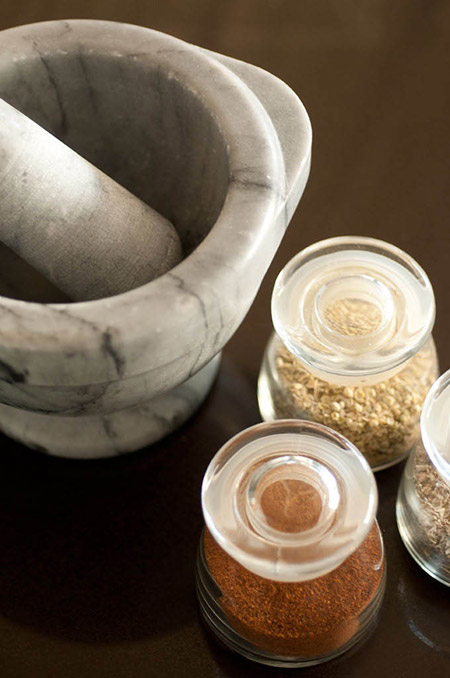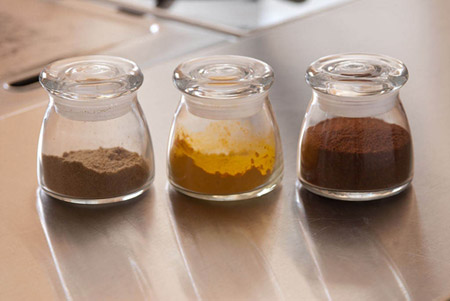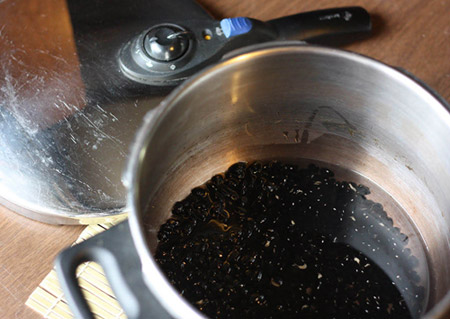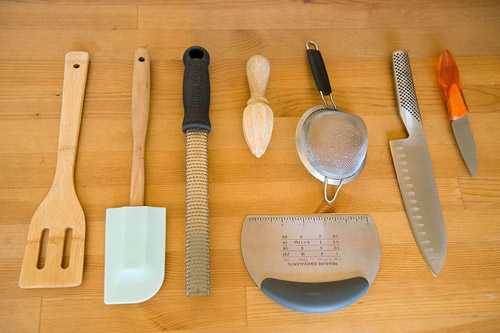Blissful Bites (4 page)


spices
These are the dried spices I most commonly use.
⢠basil ⢠bay leaves ⢠black pepper ⢠caraway ⢠cayenne ⢠celery seed ⢠chili powder ⢠cinnamon ⢠coriander | ⢠cumin, whole and ground ⢠curry powder ⢠dill weed ⢠fennel seeds ⢠garam masala ⢠ginger ⢠marjoram ⢠mint ⢠nutmeg | ⢠oregano ⢠paprika ⢠parsley ⢠rosemary ⢠sage ⢠tarragon ⢠thyme ⢠turmeric ⢠white pepper |
blissful suggestion
Buy spices in bulk at the local co-op. Buying organic spices in containers costs more than double what you would pay for bulk because you are paying for the glass container as well. I like to buy spices in a bottle and then refill the bottle with spices bought in bulk. That way I am buying only the small amount that I need, ensuring that my spices are as fresh as they can be.

Along with spices, there are other pantry basics that I always have on hand to cook with. It isn't required to have all these things, but I like to have options so I never get bored.
Everyone loves to bakeâor at least loves things baked for them! These are my essential pantry ingredients for baking, including my preferred sweeteners and flours.
I keep my kitchen pantry filled with a variety of whole grains, beans, nuts, seeds, dried fruit, and healthy snacks so I'm never caught empty-handed when I need to whip up a meal.

To get the most out of your whole foods preparation, you'll want to outfit your kitchen with basic tools that will have you cooking blissful meals in no time. Having the right tools makes cooking enjoyable and saves you time and money in the long run. Some things are essential; some are optional. I've organized tools into these two categories below.
Quality is important. Think of your kitchen tools as a lifetime investment. If you spend the money now on good-quality tools, you won't have to spend more time or money later. Remember that more expensive doesn't necessarily mean better. Discount department stores, like Ross and Marshall's, for example, carry name-brand products at a discount, so start there.
Some brands are known for being tried and true. I've included some of my favorite brands in the equipment list on the following pages.
Â
blissful suggestion
Throw out your microwave. It changes the molecular structure of the food and destroys some of its vital nutrients. You will find you're able to live without it sooner than you think. Let's start making fresh meals that nourish mind, body, and planet!
quality knives
The most important things in your kitchen repertoire are good knives. In my knife collection, I have three knives: a chef knife that I use for almost everything, a paring knife for small jobs, and a bread or serrated knife for slicing bread or soft fruits like tomatoes. Those last two knives can be any brand really; save the dough for your main knife.
I like Global, NHS, and MAC knives. I have found these to be the most durable, easy-to-work-with and sharpest chef knives; they are priced around $70 to $125 apiece. The NHS is Japanese, made from the same high-carbon steel that samurai swords are made from, so you know it's one sharp mofo. Make sure they stay sharp, and be sure to tuck your fingers while you chop so no blood is shed. Having a good sharp knife makes cooking and prepping so much easier, faster, and more enjoyable than using a dull, bad slicer. Once you try a high-quality chef knife you will never go back!
After you get this marvelous knife, you need to take care of it properly. When you are finished with it, always wash it, dry it completely, and store it in its knife guardânever leave it sitting in the sink with food crusting on it. If you leave it sitting around, it will start to rust and dull. Also, never scrape the blade side of your knife along the cutting board like they all do on those Food Network shows (my biggest pet peeve ever!). This will dull your knife. However, you can use the backside to pick up chopped veggies. (Alternatively, use a dough scraper to sweep up those veggies.) I have my chef knives professionally sharpened only twice a year because I take good care of them.
For vegan cooking, get rid of your plastic cutting boards (save them for meat products, if using, and keep separate for safety). You want a nice thick bamboo cutting board. I prefer one that is at least 20x15 with a juice groove. Simply Bamboo and Totally Bamboo are great brands.
Â
blissful trick
To keep your cutting board from slipping around, lightly dampen a paper towel or thin dish towel and place it underneath your cutting board.
One large stainless steel colander will do the trick for draining pasta and veggies. I have a variety of styles and sizes of mesh strainers for other jobs: a two-inch with a handle for catching seeds when juicing citrus, an eight-inch with a handle for sifting flour, an eight-inch stand-up for washing/straining grains, and a skimmer, which is essential for blanching vegetables.

left to right: bamboo utensil, Le Creuset spatula, Microplane zester, front: dough scraper, back: citrus reamer, mini mesh strainer, chef knife, paring knife
A good blender and food processor are essentials in a blissful kitchen. I could not survive without my Vitamix. The reason you need both is because the blender is for the more liquid things, like smoothies, dressings, pureed soups, etc., while the food processor is used for more chunky recipes that don't contain a lot of liquid, such as bean pâtés, pestos, etc. Processors also have cool attachments that help you grate and chop veggies if you are feeling too lazy to cut them by hand. Both of these are a lifetime investment and are worth every single penny. Cuisinart is tried and trueâjust go for the bigger bowl at 11 or 14 inches. You will be fine with less expensive brands, too.
Throw out Teflon nonstick and aluminum pans. There are toxic chemicals found in the coating on these pans. Replace with stainless steel, cast iron, enamel-coated cast iron, or glass. There are many new “green” companies making nonstick pans that are purported to be nontoxic. I don't feel like there's enough research to know for sure if these pans are safe, but they are great to use when making pancakes or crêpes, for toasting nuts, and for things that benefit from a nonstick surface or low-oil cooking. Use your own judgment if you want to try these pans.
Essential pans are a small saucepan, large stockpot, and both large and small sauté/skillet/fry pan. You want to have lids that fit all these pans as well. For casserole dishes, get glass or ceramic/porcelain in a variety of sizes. Pyrex makes a variety of sets that can be your new best friend. You'll need a large one that's 13x9 inches, a two-quart one, and an 8x8 inch square dish.
If you don't already have one, jump in and buy a pressure cooker. Cooking fresh beans will be a snap, and brown rice made in a pressure cooker is heaven on earth. One brand that is great and not expensive is Fagor. Or you can go fancier with Kuhn Rikon. Either way, I prefer them to rice cookers because they have more uses.
Get a variety of utensils in varying sizes with long handles, like a spoon, slotted spoon, rice paddle, ladle, whisk, and tongs. Bamboo and stainless steel utensils are better than plastic ones. When you cook with plastic, the heat is melting the utensils and thus the material's particles are going into your food. Just be sure not to use the stainless steel utensils on any cookware that can be scratched. For that cookware, use bamboo or one of my favorite tools, the
Le Creuset
spatula. It can be heated up to 500 degrees F, making it a versatile tool to have in your healthy kitchen. I also like to have a pair of bamboo cooking chopsticks. They always come in handy.